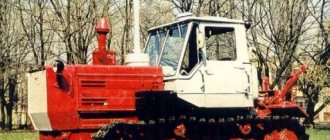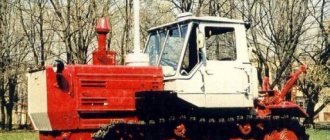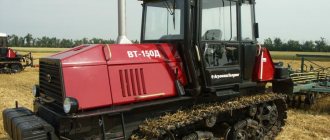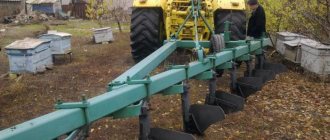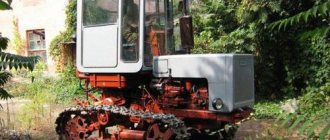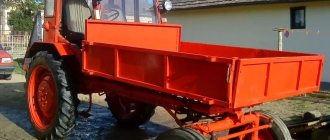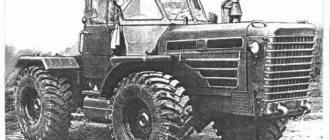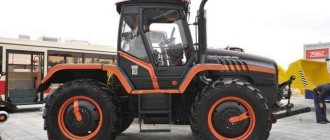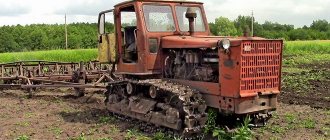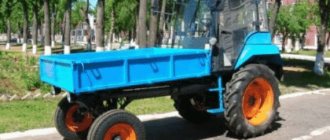From 1974 to the 21st century
T-150 is an energy-rich agricultural general-purpose crawler tractor produced by the Kharkov Tractor Plant. Produced from 1974 until recently. The most common is the energy-rich wheeled tractor T-150K, which is maximally unified with it. The differences between them are in the running systems, turning mechanisms, frames, gearboxes (unified by elements) and control systems. The development and mass production of a family of wheeled and tracked tractors that are not just related, but have the highest degree of unification, is a very difficult task. Only Soviet industry and the John Deere corporation could cope with it. About the tracked T-150 – in this publication.
Design Features
The chassis of the T-150 tractor is based on a rigid-type supporting frame, which includes two powerful longitudinal channel (box-shaped) spars, transversely connected by the front and three intermediate steel beams - cross beams, connected by rivets. Two propulsion bogies with a caterpillar belt of forty-six links each, drive sprockets, guide rollers with tension devices and shock absorbers, support and support wheels are attached to the frame through a spring suspension block.
The turning control of the tracked version of the vehicle is steering. It is also possible to include different gears on each track. Therefore, you can turn a heavy vehicle around almost in one place.
In the wheeled version, T-150K, the frame consists of two parts, hingedly connected, with the ability to rotate in a horizontal plane. On the front half-frame there is a motor, a gearbox, a cabin and a diesel fuel tank. On the rear semi-frame there is a hinged system, which is designed to secure implements. Both tractor axles, rear and front, are driven. In this case, the rear one can be turned off.
On the T-150 tractor the engine is located at the front. A clutch and a dual-flow gearbox are rigidly attached to the rear of the engine, the two output shafts of which are connected by cardan drives to the right and left bevel main gears mounted in the rear axle. The main gears are connected to the planetary final drives, on which the track chain sprockets are mounted.
The tractor can be turned in two ways. The kinematic method involves engaging, using hydraulic clutches, different gears on the left and right sides. With the kinematic turning method, both tracks remain driving (active) and the entire weight of the tractor is used to create traction force. The power method consists of reducing the oil pressure in the hydraulic clutch of the lagging side. When turning the tractor by force, the tractor is controlled by the steering wheel. The smallest turning radius is ensured by turning on the brake of the desired side, after completely disabling the hydraulic clutch.
A cabin and a diesel fuel tank with a capacity of 315 liters are installed on the gearbox. The gearbox includes transport, traction (slow), work mode and reverse. Gear shifting (there are four in total, for each of the listed modes) is carried out by hydraulic couplings - without stopping, under load and in motion. The brakes are band brakes, with two tightening branches. Hydraulic equipment: separate separate-unit system for controlling mounted and trailed machines; separate system for steering and gear shift control. The steering is hydromechanical.
Pneumatic equipment: control of the clutch and trailer brakes.
Electrical equipment: on-board network with an internal voltage of 12 V. Starter voltage – 24V. Rechargeable batteries – 6ST-190A3 (2 pcs.)
The tractor's hitch is hydraulic, single-cylinder, with 2- and 3-point adjustment.
World Star
The T-150K truly turned out to be a tractor of a fundamentally new class, not only in its powerful technical parameters, but also in design and level of comfort for the driver. Sealed comfortable cabins, a sprung tractor driver's seat, light and comfortable steering, transmissions with gear shifting on the fly, stable heavy-duty tires - all this was noted not only by domestic but also foreign experts, and the T-150K successfully entered the world market.
From 1973 to 1977, the tractor received five gold awards at international exhibitions! In 1979, during tests in the USA (International Tractor Test Site, Nebraska), the T-150K developed a thrust that was almost equal to its weight, and the Americans immediately dubbed it a tractor that can lift itself.
In 1980, the creator of the revolutionary unit, the Kharkov Tractor Plant, received the international Golden Mercury award for peace and cooperation. Thanks to the worldwide recognition of the T-150K, KhTZ has significantly increased its exports. From 1976 to 1990, 21,863 such models were delivered to the USA, Canada, Australia, Europe, Asia and Africa.
T-150 engines
The main engine of the T-150 tractor, which, in fact, was originally developed for it, is the SMD-60 diesel engine, produced by the Kharkov tractor diesel plant "Sickle and Hammer". This is a six-cylinder V-shaped liquid-cooled diesel engine equipped with turbocharging. Its operating power is 150 horsepower. The diesel engine is started by a starting gasoline engine, which, in turn, is started by an electric starter.
SMD-60.
T-150 engines are distinguished by the following technical characteristics (in parentheses are numbers for the YaMZ-236D3 version):
- Power – 150 l. With. (175).
- At a rotation speed of 2000 rpm (2100).
- Working volume – 9.15 liters (11.15).
- Weight – 0.95 t (1.00).
- Diesel fuel consumption – 217 g/kWh (220).
YaMZ-236D3.
Also, the tracked T-150s were equipped with diesel engines of the YaMZ-236M2-59 model:
- Power – 180 hp
- Rated rotation speed – 2100 rpm.
- Specific fuel consumption at rated engine power is 245 g/kWh (180 g/hp/h).
- Maximum torque – 667 N.m, at 1250-1450 rpm.
To facilitate starting the tractor engine at low air temperatures, the use of a pre-start heater PZHB-300 is provided.
Device Features
- The T-150K tractor received a six-cylinder diesel engine SMD-60. Its performance is 165 horsepower, which is achieved at 2100 rpm. The motor consumes 185 g/l. With. at one o'clock. The engine is relatively compact - weighs about 1100 kg. This unit is started by a two-stroke auxiliary motor P-350 with a power of 13.5 hp. With. To power this launcher, an electric starter was used, or the 13-horsepower launch unit was started manually. To maintain strength and prevent dry friction of parts, the diesel engine is equipped with a lubrication system with two-stage cleaning technology. Thus, the built-in filter cleaned from large and small particles. As for the internal combustion engine power system, it consists of a fuel injection pump, as well as injectors with three-point injection and a two-level fuel purification system. The fuel tank capacity is 430 liters. Among the auxiliary equipment designed to maintain engine performance, it is worth noting a cooling fan, air cleaner, compressor, generator, exhaust manifold and muffler.
- The T-150K tractor is equipped with a 12-speed mechanical transmission, which has four operating ranges - slow, reverse, work and transport. Engine power and torque are transmitted to the gearbox via a dry friction clutch. Using a 12-speed transmission, the operator varies power and torque depending on the required load. In addition, the gearbox device is represented by a drive and driven shaft with helical gears that are constantly meshed. Speeds change smoother and more clearly thanks to hydraulic clutches. These couplings, in turn, prevent power flow from being interrupted. Like many other machines, gears are changed using a lever located in the operator's cab. However, the gear range can only be changed when the machine is stopped. To increase the efficiency of the transmission, it was supplemented with its own hydraulic system, which includes a gear pump, intake and main filters, a discharge line, a camshaft with safety valves, a cooling radiator, a hydraulic accumulator, a hose and lines. In addition, the design of the chassis also includes a dry single-plate clutch, driveshaft, main and final drives, as well as a cross-axle differential and all-wheel drive. These off-road components made it possible to significantly increase geometric cross-country ability. To unlock the potential of all-wheel drive and locking, the tractor received a body with high ground clearance, minimal body overhangs and powerful protection for the engine compartment. In addition, the package includes wide-profile wheels of the same size.
- The compact dimensions of the T-150K tractor made it possible to achieve good maneuverability, as well as ease of work in cramped conditions. For example, let’s pay attention to the length of the machine including the attachment – it is 5795 mm, which is a decent result for this price category. The relatively short wheelbase of 2860mm ensures minimal approach and departure angles to improve off-road performance. The turning radius of the tractor is about 6700 mm.
- The T-150K model is equipped with a fully functional luxury cabin. Controls with an ergonomic arrangement are concentrated in the interior of the tractor. These include instrumentation, sensors and switching equipment. Thus, the driver is seated in the cabin on a sprung seat, which can be adjusted in the vertical and longitudinal directions. The following controls are installed next to the seat: steering wheel, low and high beam switches, fuel injection pump switch, accelerator pedal, clutch and brake pedal, gearshift lever, parking brake and front axle engaging levers, hydraulic system pump adjustment lever. In addition, let's pay attention to the following elements to achieve the best comfort and coziness in the cabin: noise, heat and vibration insulation of the cabin, air conditioning and heating, seat and steering column adjustment, as well as a wide glass area to improve visibility.
The T-150K tractor can be equipped with the following attachments:
- Disc huller
- Various types of plows
- Disc harrow (heavy and standard)
- Cultivator
- Seeder
- Compacting roller
- Towed combine harvester
- Fertilizer spreader
- Semi-mounted and three-axle trailers
- Flat cutter cultivator
- Harrow
- Seeder-cultivator for planting grain crops.
The tractor received the following modifications:
- T155 – engineering military equipment for transporting artillery pieces
- T-155K - wheeled tractor for engineering troops and artillery
- T-156 – front loader with a spacious bucket with a volume of 1.3 cubic meters
- LT-157 – skidding tractor for logging work
- T-158 – wheeled tractor for industrial, technological and transport operations
- T-150KD is a wheeled tractor with a bulldozer blade.
Transmission
The designs of gearboxes for tracked and wheeled versions of the tractor are unified, the main gears are made in the form of planetary gearboxes. In the tracked version of the T-150, the gearbox is dual-flow, with the ability to transfer movement to the selected track. On the T-150K wheeled tractor, torque is transmitted to the drive axles from the gearbox through a transfer case. The gearbox is also equipped with a power take-off shaft, which drives the implements.
The gearbox of the T-150 crawler tractor is multi-range (with slow/traction, working, transport and reverse). In each of these ranges there are four gears, switched by hydraulic clutches without interrupting the power flow. But the ranges are switched only when the tractor is completely stopped. Also from the gearbox is the PTO drive – the power take-off shaft.
The left and right output shafts of the gearbox are equipped with personal hydraulic clutches that connect these shafts to the driven gears of all gears. When changing gears, the hydraulic clutch of the next gear is first engaged, after which the hydraulic clutch of the previous gear is turned off. For a moment, both clutches remain engaged, and this ensures a seamless shifting pattern.
...plus wheels!
Finally, in 1967, Kashuba turned to the chief engineer of KhTZ V.V. A book with a proposal to develop at the plant a fundamentally new model of a powerful high-speed caterpillar tractor. However, the chief engineer set his own condition: that the new tractor be unified - have the possibility of both tracked and wheeled modifications.
This was a real challenge, because creating a unified unit is much more difficult than creating a tracked or wheeled unit separately. Nevertheless, the plant, the team and the chief designer coped with this task! As a result, tractors like the T-150 were born. In 1973, the State Commission approved their serial production, and in 1974 a Resolution was adopted on the creation of capacities for their production.
The wheeled model has gained great popularity. The wheels made it possible to use the tractor not only in the fields, but also for road work: the T-150K is adapted for movement on highways.
Chassis and suspension
The T-150 crawler tractor moves with the help of two caterpillar chains, each of which is located on two sprung balancer suspension carriages and two support rollers. The propulsion unit has coil springs and hydraulic shock absorbers, which are designed to reduce shocks from collisions with various bumps and obstacles.
The tractor is equipped with a spring-balance suspension with four spring-balance carriages, each of which is equipped with two swing axes. The tracks are 420 mm wide. Link pitch – 170 mm.
Engine SMD 60
The SMD 60 power unit is designed for T-150 tracked tractors produced by the KhTZ plant. The SMD 62 engine is for the wheeled modification of the T-150K, respectively.
Description of the SMD-60/62 device:
- Number of cylinders – 6 pcs.
- Number of cycles – 4.
- Power – 150 l. With.
- Type of cooling - liquid (in summer, water is poured into the system, at negative ambient temperatures - antifreeze).
- Diesel fuel injection is direct.
- Turbocharging – available.
- The arrangement of the cylinders is y-shaped with offset.
- The piston stroke is less than the cylinder diameter - a short-stroke version.
The engine includes:
- fuel injection pump;
- coarse and fine fuel filters;
- engine oil is purified using a special centrifuge;
- cyclonic air cleaner (dust is removed from it automatically);
- starting motor P-350;
- pre-heating device;
- alternator,
- The engine turbocharger is located in the cylinder camber.
The main difference between the SMD 62 and the base model is the transition to increased power of 165 hp. The pneumatic system of the T-150K tractor is equipped with a special injection compressor.
Cabin T-150
The T-150 tractor cab is a two-seater cabin, noise-, dust- and protected, and since 2013, also equipped with a safety cage. The cabin is equipped with heating, ventilation, windshield wipers, and a sun visor. There are rear-view mirrors and a device for blowing glass.
The cabin has two soft seats. The main thing is sprung; it can be adjusted in height. The cabin is equipped with lighting, a heater, a thermos for water, a place for a first aid kit and hooks for hanging clothes.
Cabin equipment
Among the main operational characteristics is an increased level of comfort. The all-metal frame for the cabin makes it resistant to loosening. All-round glazing provides all-round visibility and simplifies control of equipment.
A fan and air conditioner are installed inside the cabin, which allow you to regulate the microclimate in the cabin to the maximum level. The standard configuration instrument panel is equipped with control sensors: speed, coolant temperature, diesel and oil volume.
Differences from its predecessor - the T-74 crawler tractor
The T-150 differs from its predecessor in increased operating weight (one and a half times) and diesel engine power (more than twice). Also in its design, a shift of the center of gravity forward, relative to the middle of the supporting surface, is implemented. This allows, when applying traction force, to equalize the pressure along the entire length of the support surface of the track chain. The center of gravity was shifted by separating the gearbox with the turning mechanism from the rear axle and moving them forward, directly to the engine.
Compared to the T-74, the T-150 provides a significant increase in productivity by operating at higher speeds and with greater thrust. It reduces the harmful effects on the fertile soil layer - pressure and slipping. Transmitting power in 2 streams can significantly reduce loads, strengthen the durability of all transmission components, reduce its dimensions and raise ground clearance. In terms of working conditions, the T-150, of course, was much preferable to the more archaic T-74.
Engine
All modifications of the T-74 tractor were equipped with the same SMD-14A engine, produced at Kharkovsky. This four-cylinder diesel engine is well known to specialists who worked at MTS during the USSR. Among its design features we should mention:
- Water cooling,
allowing the power unit to operate for a long time at high loads.
- Working volume
6.33 liters with a cylinder diameter of 120 mm and a piston stroke of 140 mm.
- Wet cylinder liners,
providing quick engine repair in the field.
- Vortex chambers
combustion.
- Bottom position
camshaft.
- Top position
valves, the opening force to which was transmitted through pushers.
- Maximum power
75 l. With.
- Fuel consumption
– 195 g/l. With. at one o'clock.
- Dry weight
– 675 kg.
To start the engine, a PD-10M-2 gasoline starting unit equipped with an electric starter is used. It should be noted that the cylinder block design with wet liners, which became widespread at that time, although it improved the maintainability of engines, but reduced their overall service life compared to units made according to a monoblock design .
In comparison with the wheeled version - the T-150K tractor
Compared to its wheeled version, the T-150 has a very low transport speed and cannot travel on paved roads. There are real difficulties when aggregating a crawler tractor with heavy mounted implements - due to its shorter wheelbase.
The advantages of the tracked T-150, compared to the wheeled version, are: reduction of harmful effects on the ground (specific pressure by 2 times, and slipping by three times); increase in traction force by about 20-30 percent; higher productivity of the tractor unit; lower (10% less) diesel fuel consumption.
Attachments
The choice of attachments depends on the industry in which the tractor is used. When used in agricultural production, they can be aggregated with a plow, a combined tillage unit, a cultivator, a harrow and other options for sowing, harvesting and watering.
The municipal service uses HTZ T-150 with dumps of various shapes, brush equipment, and a snow blower. This could be trailed watering equipment, a mounted sand spreader, a roadside widener, and the like. The tractor can be combined with a mower, milling cutter, hydraulic drilling rig, and water pumping unit. The list of attachments for the Kharkov machine includes a loader, bulldozer equipment, and various dump devices.
Bulldozer modification
Based on the T-150 tracked tractor, a modification of the T-150D with bulldozer equipment was developed. This crawler tractor was routinely equipped with a non-rotating bulldozer blade 05-09-25-06, designed for energy-intensive agricultural and road construction work. The width of this standard bulldozer blade of the T-150D tractor is 2520 mm, the lifting height is 800 mm, and the lowering depth is 400 mm.
Power plus speed...
The development of high-speed tractors was undertaken by the chief designer of KhTZ B.P. Kashuba. In particular, he created an experimental series of high-speed tracked tractors DT-54M. Together with the All-Russian Research Institute of Agricultural Mechanization, laboratory and field studies were carried out at high speeds (5-9 km/h). The tests were successful, proving that the path of modernizing tractors towards speed is quite promising.
HTZ began producing a series of high-speed tractors almost like hot cakes! 1960 - the first high-speed tracked tractor T-75 in the USSR, 1962 - T-74. The operation of these machines has shown that it is possible to further increase operating speeds and it is quite possible to create even faster models.
Technical specifications in numbers
- Traction class – 3 t.
- Operating weight – 8.25 tons.
- Overall dimensions: length – 4.325 m; width – 1.85 m; height – 2.895 m.
- Base – 1.86 m; track - 1.435 m.
- Road (agrotechnical) clearance – 300 mm.
- Maximum forward – 15.65 km/h; back – 7.80 km/h.
- Lowest speed: forward – 4.30 km/h; back – 5.80 km/h.
- The power take-off shaft is two-speed, with a rotation speed of 1000 or 540 rpm.
- Track width – 1.45 m.
- Track width – 420 mm.
- Specific soil pressure is 0.46 kg/cm2 (for the wheeled version - 3.42 kg/cm2).
- The lifting capacity of the attachment is 3.5 tons.
- Fuel tank capacity – 315 liters of fuel. There were also tractors with 430-liter fuel tanks.
- Filling parameters: engine oil - 19.8 l, steering oil - 33 l, gearbox - 38 l, hydraulic system - 50 l, drive axle - 34 l, PTO gearbox - 3.6 l, coolant - 41 l.
- Maximum load capacity – 4200 kg.
- Pump capacity – 86 l./min.
- The number of free pairs of distributor hydraulic outlets is 2.
- Turning radius – 2.35 m.
Description of SMD engines
Modifications of diesel internal combustion engines produced under the SMD brand have common advantages:
- Economical, low diesel fuel consumption.
- Compact design.
- Relatively small mass.
- Availability of changeover (most often it is necessary to change the power of the unit).
- A large number of spare parts at affordable prices in the retail chain.
- Low cost of the unit in comparison with imported analogues.
Due to the large number of advantages of these motors, they are widely used in the production of agricultural machinery. SMD motors include high-pressure hydraulic pumps for servicing the hydraulic system. Along with the pumps, special spark arresters are additionally installed on agricultural machines. The design of the engines includes fine fuel filters. Their design allows for cleaning and rinsing without dismantling or disassembling.
Depending on the area of use and design of modifications, power units of the SMD brand are divided into the following categories:
- four-cylinder, cylinder arrangement – in-line;
- six-cylinder, in-line;
- 6-cylinder, U-shaped.
Owner reviews and areas of application
The main advantage of using the T-150 crawler tractor is the prevention of soil compaction, while maintaining the fertile layer. The use of this tractor allows you to perform agricultural work in difficult soil and climatic conditions, with high traction characteristics. T-150s were effectively used (and some continue to be used) in the following work: pre-sowing and main tillage on large plots of land - plowing, land cultivation; sowing work using productive wide-cut sowing complexes; procurement of feed and laying silage for storage; cleaning work in combination with specialized equipment.
The versatility and high performance of the T-150 tractor provides the ability to use a wide range of trailed specialized equipment - more than fifty items in total. A powerful motor, decent operating speed, and a pendulum mechanism for coupling trailed equipment allow the machine to be used for arable work, towing seeders, cultivators, harrows, sprayers, etc. The machine is effective in forming and filling silo pits. Crawler tractors T-150 and bulldozer modification T-150D have been used, and continue to be used, in road and industrial construction, forestry, land reclamation, quarrying and mining.
In reviews, owners and machine operators of T-150 tracked tractors evaluate this equipment extremely positively as extremely reliable, unpretentious and durable. The T-150 rarely breaks down, it is very easy to maintain and repairable: it has easy access to the main components; a small number of lubrication points reduces maintenance and repair time; spare parts and consumables are inexpensive.
The disadvantages of this model include: high diesel fuel consumption; a short wheelbase, which does not allow to provide the required parameters for towing wide-cut plows; the need to exert significant effort when using the steering column. Also, if the plots of land for cultivation are scattered, which is why you have to wander from one to another, then using tracks turns out to be a long, fuel-intensive and generally inconvenient process. And in our time, to these disadvantages one cannot help but add the very high cost of the tractor.
A more modern incarnation of a caterpillar tractor from the Kharkov plant is the KhTZ-181. It is more powerful than the T-150: it is equipped with an eight-cylinder diesel engine and belongs to the fourth, and not the third, traction class.
Typical faults and methods for their elimination
Despite the reliability of the T-150K machines, like any equipment, they are subject to wear and tear. Among the most common problems:
- cardan heating . To eliminate this, you need to inspect the radial clearance on the needle-type bearings. If the distance exceeds 0.5 mm, then the crosspiece needs to be replaced. In cases where the gap is less than the specified parameter, lubrication of the unit will help;
- radial runout of the cardan . It is necessary to check the gearbox flanges for mobility. If they are loose, then you need to tighten the fasteners;
- Attachment does not lift . The reason lies in the failure of the hydraulic pump. This happens when it is turned off, the oil in the system is cold, or debris gets on the edge of the seat in the bypass valve.
Important: if worn parts are identified during the inspection, they must be replaced with new ones, even if the tractor continues to operate. The operation of special equipment using spare parts that have exhausted their service life is the main cause of serious breakdowns, machine failure and leads to expensive repairs.
Cost of the T-150 caterpillar tractor
The new tractor T-150-05-09-26 (with diesel engine YaMZ-236M2-59 180 hp) costs 4,420,000 rubles. After a long period of downtime, the Kharkov Tractor Plant resumed work in February 2022. Despite the fact that, according to reports from the new management and the government of Ukraine, KhTZ produced 794 tractors in 2017 and for the first time “closed the year” with a profit rather than a loss, the warehouse balances of tractors from previous years of production are still not sold out. The demand for both classic models and modern Kharkov tractors (modernized analogues of the T-150 and T-150K) is limited by their high price.
There are few used tracked T-150s on the secondary agricultural machinery market, unlike their wheeled “brothers.” They ask for from 200,000 to 1,100,000 rubles, depending on the year of manufacture and technical condition.
After production of the SMD-60 engine ceased, a six-cylinder V-shaped, liquid-cooled YaMZ-236D3 engine was installed on the tractor - without turbocharging, but with an operating power of 170 horsepower. Its manufacturer is Yaroslavl Motor).
Predecessors
T-150K is not the first powerful wheeled tractor that was created at KhTZ.
Back in 1959, N. S. Khrushchev, after a trip to the USA, decided to “catch up and overtake” American farmers using wheeled tractors instead of tracked ones, and entrusted the development of a worthy competitor to the Kharkov tractor class=”aligncenter” width=”900″ height=”664 ″[/img] KhTZ Chief Engineer A. A. Soshnikov successfully completed this task. Under his leadership, a powerful wheeled tractor T-125 was created - a fundamentally new original model that has no analogues. It is believed that this tractor became the prototype of the T-150K. By the way, the T-125, like the T-150K, was a unified type vehicle, and it could be produced in a tracked version.
But still, we note that there was a fairly long gap between the release of the T-125 and T-150K models, during which the development of high-speed tracked tractors was carried out at the Kharkov plant. It was thanks to this experience that the T-150K was able to appear - the first powerful and high-speed wheeled tractor.
Device
Engine
At first, the unit was equipped with an SMD-60 engine, but later they began to use instead a newer and more efficient diesel engine YaMZ-236D-3 with six cylinders arranged in a V-shape, which is not supercharged. It starts with an electric starter. The engine is located at the front.
Transmission
In the tracked model, the gearbox with planetary final drive is dual-flow, with power transmitted to each track. In addition to the operating mode, reverse, transport and slow motion are possible. Changing one to the other is possible only when the tractor is stopped. Each range has four gears switched by hydraulic couplings. When you need to turn, one of the clutches slips in the gearbox, causing one of the tracks to lag.
The wheeled model also has a mechanical transmission, and the gearbox is equipped with hydraulic clamping couplings. But here there are two half-frames with drive axles connected by hinges (the rear axle can be disconnected). The front half frame is the basis for the cabin, gearbox and engine, the rear half frame is for the drives of mounted mechanisms. Changing the pressure in the hydraulic cylinders allows you to change the angle between the semi-frames - this is how the unit is controlled. It is possible to rotate horizontally.
Chassis
The tracked model has two track chains for movement, each of which is supported by two support rollers and two balancing carriages equipped with springs. Shock absorbers with springs serve to soften shocks when hitting obstacles.
Photo of the T-150 bulldozer on caterpillar tracks
The rear and front wheel sets (for the wheeled model) are absolutely identical. Wheel formula – 4x4. Each of the wheels is driven; they are equipped with wide tires with low air pressure inside. Thanks to this, there is good adhesion to the ground in any weather. The shock absorber is an independent spring suspension at the front axle.
Hydraulics
Steering is carried out by a hydraulic booster, working in tandem with a pump. If the amplifier fails, the steering control does not stop working. The hydraulics of the mounted system are separate and aggregate. It consists of a gear-type pump, hydraulic distributor, tank with filter, power cylinders and pipelines.
Electrics
Electrical devices are powered by two batteries located at the bottom (behind the left footrest).
There is an IR-1 mode indicator that can monitor the number of engine hours, speed, emergency oil and cooling fluid pressure, filter clogging, and battery charge state.
The windshield wipers, step lighting (turns on when the door is opened), and the lamp are also powered by electricity.
Operator's cabin
The sealed cabin with circular glazing has a rigid frame, as well as thermal insulation, protection from noise and dust. There is a sun visor in front, the windows are equipped with a blower and glass cleaners. In cold weather, heating is provided, and in warm weather, ventilation is provided. The cabin has two soft seats. The driver's seat is adjustable and equipped with springs.
Engine SMD 14
The four-cylinder diesel engine SMD 14A is included in the Kharkov T-74 tractor, and the SMD-14B is intended for the serial tractor DT-54V, produced at the Volgograd Tractor Plant.
Technical characteristics of the SMD 14 engine
- The rated power of the engine is 75 horsepower.
- Number of cylinders – 6 pieces, diameter – 130 mm.
- The cylinder arrangement is U-shaped, with a camber angle of 90°.
- Crankshaft speed 800 – 2180 rpm.
- The piston stroke length is 115 mm.
- Cooling system type – water.
- Ventilation of the cooling system is forced type.
- The SMD-14 includes a starting system with a P-350 motor.
Brief overview of SMD models
The SMD 15N and 14N engines are not equipped with turbines and belong to the category of naturally aspirated engines. Thanks to the increased power indicators (68 hp), they have found application in such areas as:
- tractors "Yumz";
- road equipment (loaders, asphalt pavers, rollers);
- construction equipment.
Four-cylinder turbocharged diesel engines SMD-17N, 18N with a power of at least 100 horsepower are installed:
- on agricultural tractors Vg TZ, DT-75;
- forest modifications LHT-55 “OTZ”, TDT-55;
- ATEK excavators.
